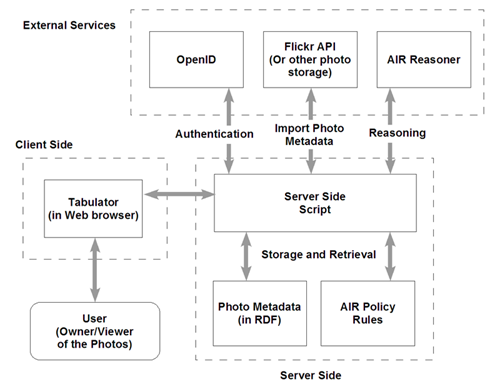Photo Access Control Project
Introduction
Photo sharing on the Web is very popular among Web users nowadays. Websites such as Flickr allows users to upload their photos to the Web and describe them using tags. At the same time, there is also a rising concern about privacy or access control among the users. Users may not want to share all of their photos with all other users on the Web.
Currently, Flickr allows users to choose whether a photo should be visible to all other users, to only their friends or family members, or be completely private. However, more specific access controls such as making a set of photo visible only to one's colleagues are not possible. This project aims at providing a solution to this problem by combining tagging with linked data on the Semantic Web as well as OpenID authentication method. The goal is to allow users to specify access control rules based on, for example, the social network information contained in their FOAF (Friend-of-A-Friend) profile and possibly other linked data on the Web.
Objectives
- To provide a more flexible system for users to specify access control rules to their photo collections using existing tags.
- To provide such a system which is also easy to set up by taking advantages of existing tools: OpenID for authentication, the AIR reasoner for reasoning on access control rules, and the Tabulator for user interface.
- To demonstrate the advantage of reusing existing data on the Web and of combining metadata from different sources.
System Design

Figure 1. System Architecture
Acknowledgements
This document describes research work carried out by Albert Au Yeung while he was visiting the Decentralized Information Group (DIG) at CSAIL, MIT, as part of the Web Science Exchange Program organised by the Web Science Research Initiative (WSRI) with the support from an EPSRC Grant (No. EP/F013604/1). This work was carried out under the supervision of Lalana Kagal and Tim Berners-Lee. The author also thanks other members of DIG for contributing their ideas to the project in various occasions.
Publication
- Ching-man Au Yeung, Lalana Kagal, Nicholas Gibbins, Nigel Shadbolt. Providing Access Control to Online Photo Albums Based On Tags and Linked Data. AAAI 2009 Spring Sympoisum: Social Semantic Web: Where Web 2.0 Meets Web 3.0, March 23-25, 2009, Stanford, California, USA.
References
- Tim Berners-Lee, Yuhsin Chen, Lydia Chilton, Dan Connolly, Ruth Dhanaraj, James Hollenbach, Adam Lerer, and David Sheets. Tabulator: Exploring and Analyzing linked data on the Semantic Web. In Proceedings of the 3rd International Semantic Web User Interaction Workshop.
- Piero A. Bonatti, Claudiu Duma, Norbert E. Fuchs, Wolfgang Nejdl, Daniel Olmedilla, Joachim Peer and Nahid Shahmehri. Semantic Web Policies - A Discussion of Requirements and Research Issues. In Proceedings of 3rd European SemanticWeb Conference, Budva, Montenegro, 11th–14th June 2006, volume 4011 of LNCS, 712–724.
- Rita Gavriloaie, Wolfgang Nejdl, Daniel Olmedilla, Kent E. Seamons and Marianne Winslett. No Registration Needed: How to Use Declarative Policies and Negotiation to Access Sensitive Resources on the Semantic Web. In Proceedings of the First European Semantic Web Symposium, Heraklion, Crete, Greece, May 10-12, 2004, volume 3053 of LNCS, 342–356. Springer.
- Lalana Kagal, Tim Berners-Lee, Dan Connolly and Daniel J. Weitzner. Using semantic web technologies for policy management on the web. In Proceedings of The Twenty-First National Conference on Artificial Intelligence and the Eighteenth Innovative Applications of Artificial Intelligence Conference, July 16-20, 2006, Boston, Massachusetts, USA. AAAI Press.
- Andrew D. Miller and W. Keith Edwards. Give and take: a study of consumer photo-sharing culture and practice. In Proceedings of the SIGCHI Conference on Human Factors in Computing Systems, 28 April - 3 May 2007, San Jose, California, USA, 347–356. New York, NY, USA: ACM.
- Amin Tootoonchian, Kiran K. Gollu, Stefan Saroiu, Yashar Ganjali and Alec Wolman. Lockr: social access control for web 2.0. In WOSP ’08: Proceedings of the first workshop on Online social networks, Seattle, WA, USA, August 18, 2008, 43–48. New York, NY, USA: ACM.
- Mariemma I. Yagüe, Antonio Maña, Javier López and José M. Troya. Applying the semantic web layers to access control. In DEXA ’03: Proceedings of the 14th International Workshop on Database and Expert Systems Applications, 622. Washington, DC, USA: IEEE Computer Society.
